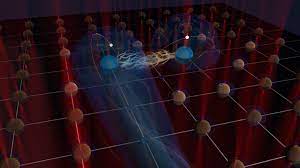Source: Universität Stuttgart
In our fast-paced technological landscape, the boundaries of classical computing are being pushed, and new horizons are being sought through the fascinating realm of quantum mechanics. One of the latest breakthroughs in this field revolves around the potential applications of Rydberg atoms in quantum computers.
Unveiling Rydberg Atoms
Imagine atoms with their outer electrons situated in the highest energy orbits. These intriguing structures are known as Rydberg atoms. When electrons are in these lofty energy states, they take on orbits that are unusually distant from the atom's core. As a result, the atom's behavior changes dramatically. The notion of electrons roaming in remote orbits not only alters the atom's size but also amplifies its interaction capabilities.
The Alluring Traits and Applications of Rydberg Atoms
Rydberg atoms boast distinct characteristics that hold promise for quantum computing:
Extended Interaction Reach: Due to their outer electrons’ distant orbits, Rydberg atoms can establish connections that span impressive distances. This unique feature is vital for constructing quantum gates and facilitating information processing maneuvers.
Exquisite Sensitivity: These atoms exhibit remarkable sensitivity to external forces like magnetic and electric fields. This attribute could be harnessed to fortify error-correction mechanisms within quantum computers.
Harnessing Magnetic and Electric Forces: Rydberg atoms respond remarkably well to external magnetic and electric fields. This ability facilitates meticulous design and manipulation of quantum gates, enhancing their controllability.
Juggling Multiple Interactions: Rydberg atoms possess the knack for engaging with multiple atoms concurrently. This ability fosters parallel computation prowess, elevating the processing speed of quantum computers.
Rydberg Atoms and the Quantum Computing Frontier
Quantum computers harness qubits, the quantum counterparts to classical bits. Qubits can gracefully inhabit both 0 and 1 states simultaneously, revolutionizing the pace of computation.
Rydberg atoms emerge as potential game-changers in the realm of quantum computers. These atoms are prime candidates for representing and manipulating qubits. Their impressive long-range interaction capabilities fast-track robust connections between qubits. Furthermore, their responsiveness to magnetic and electric fields facilitates seamless transitions between desired states.
Rydberg Atoms as Quantum Heroes
Employing Rydberg atoms as qubits in quantum computers paves the way for exciting applications:
Amplified Computational Prowess: Rydberg qubits can tackle intricate challenges that classical computers would labor over for years. Applications span diverse domains, including optimizing chemical reactions, designing advanced materials, and performing rapid database searches.
Virtual Reality Through Quantum Simulations: Rydberg qubits hold the potential to simulate complex physical and chemical scenarios. This offers insights into drug development, material behavior analysis, and refining processes in the energy sector.
Guardians of Secure Communication: Rydberg atoms can bolster quantum cryptography. Their long-range interaction capabilities enhance the security of quantum key distribution protocols, ensuring safe data transmission.
A Glimpse into Tomorrow
Rydberg atoms stand on the brink of transforming quantum computers and pushing the boundaries of computation itself. As research progresses, these atoms might unlock a realm of rapid and robust calculations, revolutionizing industries and advancing our understanding of the universe.

Comments
Post a Comment